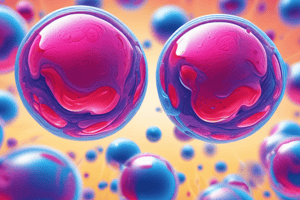Podcast
Questions and Answers
What percentage of membrane proteins are transporters?
What percentage of membrane proteins are transporters?
Up to 30% of membrane proteins are transporters.
Explain the factors that influence the relative permeability of the lipid bilayer to molecules.
Explain the factors that influence the relative permeability of the lipid bilayer to molecules.
The relative permeability of the lipid bilayer is influenced by molecule size and solubility in hydrophobic fatty acids of phospholipid molecules. Polar molecules are impermeable to the lipid bilayer, while smaller and less polar molecules diffuse more rapidly across the bilayer.
What is the rate of passive polar diffusion of non-polar diethylurea compared to urea, and why?
What is the rate of passive polar diffusion of non-polar diethylurea compared to urea, and why?
The rate of passive polar diffusion of non-polar diethylurea is 50 times greater than urea due to its non-polar ethyl groups.
Explain the types of passive transport through biological membranes.
Explain the types of passive transport through biological membranes.
Define osmosis and explain the terms isotonic, hypertonic, hypotonic, and osmotic pressure.
Define osmosis and explain the terms isotonic, hypertonic, hypotonic, and osmotic pressure.
Flashcards are hidden until you start studying
Study Notes
Membrane Protein Transporters
- Approximately 30% of membrane proteins are transporters
- Transporters mediate the movement of molecules across biological membranes
Permeability of the Lipid Bilayer
- The lipid bilayer is more permeable to small, nonpolar molecules like oxygen, carbon dioxide, and steroids.
- Polar molecules, such as ions and glucose, have difficulty crossing the lipid bilayer due to their interactions with water.
- Factors influencing permeability:
- Size
- Polarity
- Charge
Passive Diffusion of Urea and Diethylurea
- Diethylurea, a nonpolar molecule, diffuses passively across the lipid bilayer much faster than urea, a polar molecule.
- This is because diethylurea can dissolve in the hydrophobic interior of the membrane, while urea cannot.
Passive Transport
- Simple diffusion: Movement of molecules down their concentration gradient directly across the membrane.
- Facilitated diffusion: Movement of molecules down their concentration gradient with the assistance of membrane proteins.
Osmosis
- Osmosis is the movement of water across a semipermeable membrane from a region of high water concentration to a region of low water concentration.
- Isotonic: The concentration of solutes is the same inside and outside the cell.
- Hypertonic: The concentration of solutes is higher outside the cell than inside the cell.
- Hypotonic: The concentration of solutes is lower outside the cell than inside the cell.
- Osmotic pressure: The pressure required to prevent the movement of water across a semipermeable membrane.
Studying That Suits You
Use AI to generate personalized quizzes and flashcards to suit your learning preferences.




